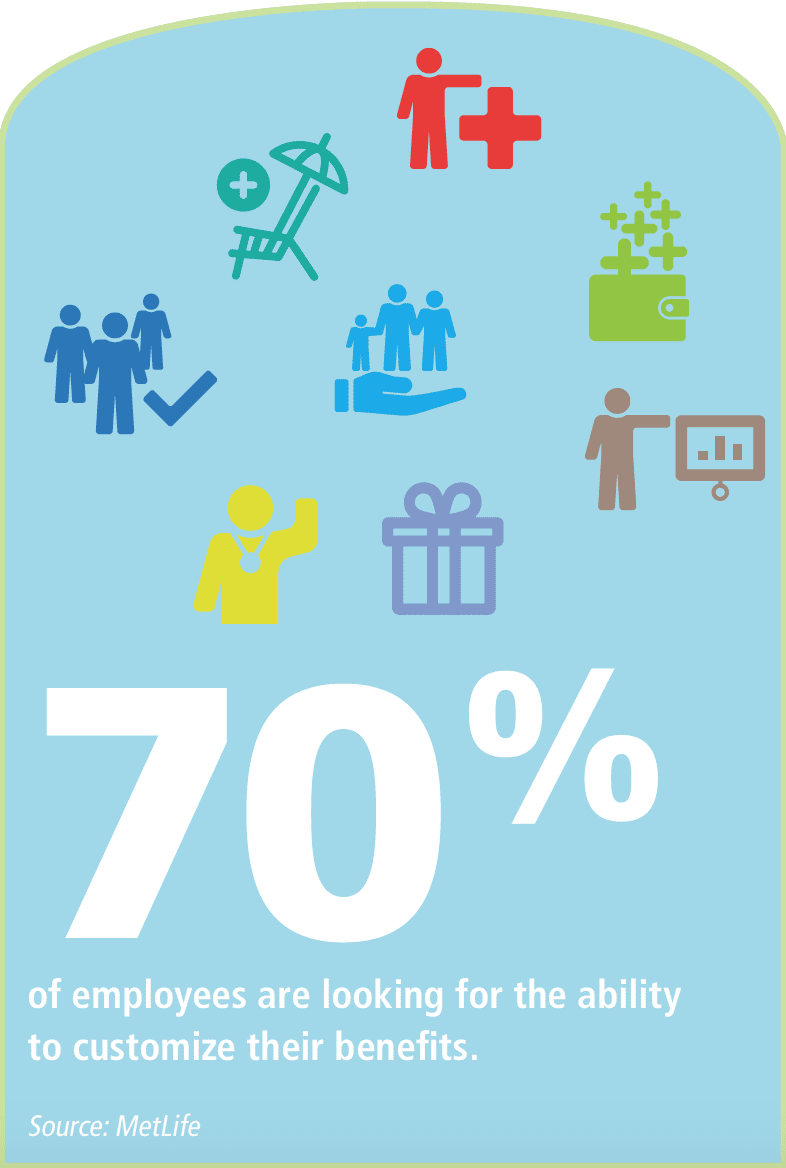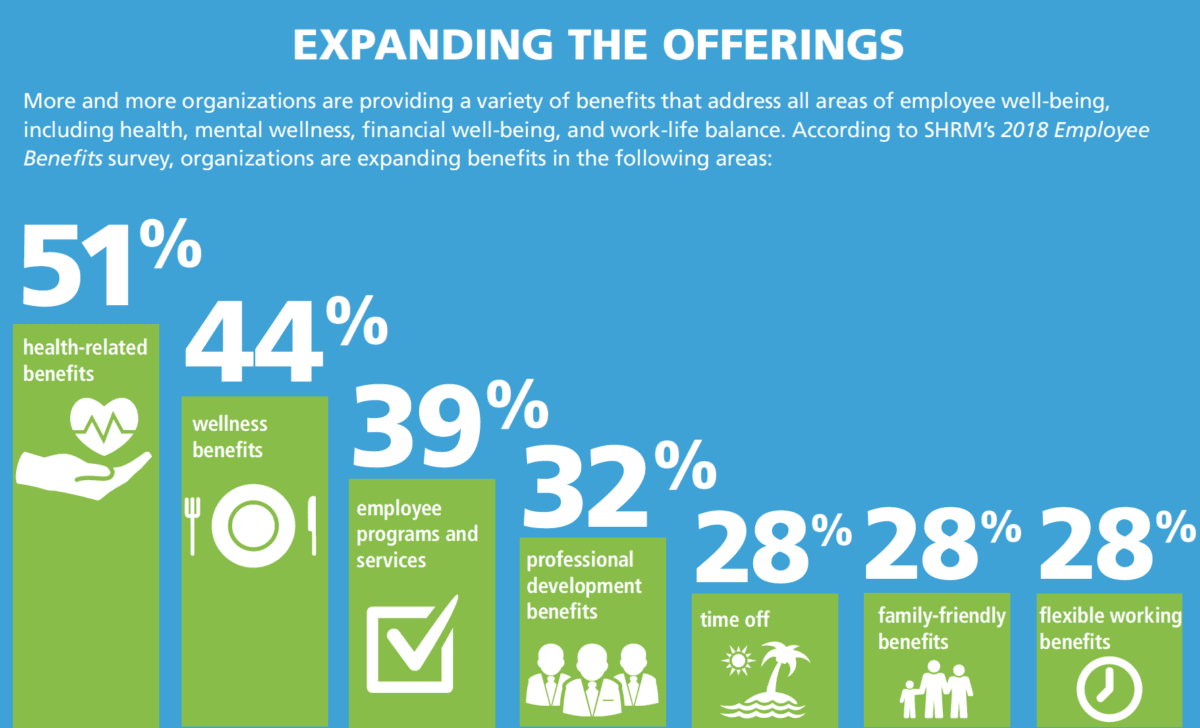A holistic benefits plan is at the top of the wish list for today’s employees -here’s how to create one that stands out.
By Marta Chmielowicz
In today’s mobile and ultra-connected world, the line between personal and professional lives is often blurred. The days of a traditional nine-to-five job are long gone. Employees across all generations are electronically tied to the office and have the ability to work outside of traditional hours. As a result, some organizations are playing an active role to ensure that their employees remain happy and healthy in all facets of their lives.
Many companies are stepping up to the plate by offering holistic benefits packages that encompass the entire spectrum of employee wellness. In fact, SHRM’s 2018 Employee Benefits survey shows that over one-third of surveyed organizations (34 percent) increased their benefits offerings in the past year, and the number of offered benefits has tripled. The top reasons cited for increasing benefits were retaining employees (72 percent), attracting new talent (58 percent), and responding to employee feedback (54 percent).
“What’s happened is there’s this new work environment that’s radically different from 20 years ago -even from 10 years ago,” says Lorna Borenstein, CEO of on-demand wellness provider Grokker. “Attracting and retaining talent has become more difficult and more important than ever, and the employee is in the driver seat and she knows it. She wants her employer to care about her whole self, not just the part of her that shows up to accomplish the work task. So, employers have begun to offer the kinds of new age benefits that she wants -benefits to help her when she feels busier and more stressed than ever.”
According to SHRM’s research, organizations are expanding benefits in the following areas:
- health-related benefits (51 percent);
- wellness benefits (44 percent);
- employee programs and services (39 percent);
- professional development benefits (32 percent);
- time off (28 percent);
- family-friendly benefits (28 percent); and
- flexible working benefits (28 percent).
These benefits go beyond the physical aspects of wellbeing to meet the unique needs of every generation of employees and create a happy, healthy, and productive workplace culture.
Step One: Filling the Gaps
A good benefits program should be as diverse as an organization’s employees -but deciding what to include can be a challenge. To evaluate their existing benefits plans, HR professionals should consider these four steps:
1. Talk to employees. “As the workforce is changing at a rapid pace, business leaders need to rely on continuous two-way communication with employees, not only to ensure they are making the most of their benefits offering, but to evaluate whether their benefits are a good fit,” says Chris Bruce, co-founder and managing director of Thomsons Online Benefits.
While it can be tempting to make assumptions about the needs of each generational group in the workforce, relying on stereotypes may not accurately reflect employees’ priorities. For example, HR professionals may assume that older employees are focused solely on retirement planning, but Thomsons Online Benefits’ Global Employee Benefits Watch 2017/18 report shows that nearly 30 percent of employees aged 65 and over desire benefit plans that support home ownership and over a third seek further career progression. Likewise, millennials also defy stereotypes; according to survey results, 25 percent do not prioritize traveling and only 17 percent ranked opportunities to socialize at work as important.
In order to get a more accurate pulse on employee needs, BenefitFocus Senior Vice President Jeff Oldham says that HR leaders should survey their workers at every open enrollment. “They should definitely ask a handful of basic questions -are the benefits that we’re offering satisfactory? What benefits are we not offering that you’d be interested in? We highly recommend engaging and surveying your workforce. Don’t make assumptions -ask your population what they want.”
2. Leverage data. In addition to getting direct feedback from employees, Oldham recommends that HR leaders conduct a demographic analysis of their workforce that measures metrics such as employee age, generation, number of years employed, and income, and then analyzes each group’s participation rates for existing benefits plans.
“For example, examining retirement plan data such as contribution rates, average balances, and loan frequency and amounts can provide important clues that may indicate the need for a more robust voluntary benefit package that includes accident and health products, as well as a need for a financial wellness solution,” explains Bradd Chignoli, MetLife‘s senior vice president of national accounts and group benefits. “[This can help] employees be better financially prepared for unexpected healthcare or other costs that could hinder their ability to save.”
By leveraging this data, organizations can identify patterns among employees and more accurately evaluate areas where adjustments can be made.
3. Experiment and measure results. Once armed with demographic data and employee feedback, Grokker’s Borenstein says that HR leaders can begin to experiment. “You need to think about just one or maybe two areas of focus -narrow your priorities,” she explains. “Start small but be very defined in what you are going to try. Make sure that you are able to create goals around what it is that you are attempting that are smart, measurable, and achievable. And you need to experiment. Don’t expect that everything you try is going to be a home run -it takes time to craft and evolve your program just like it does for any product or service.”
For example, Aetna recently partnered with Grokker to develop a benefits plan to improve insurance quality for its lower income employees while teaching them how to make healthier food choices. With these specific goals in mind, the company launched the “Enhanced Benefits Program,” which gives free coverage to all low-earning employees who complete a 21-day nutrition course. Follow-up survey results found that 97 percent of program participants reported new healthy habits, 90 percent were healthier and more energetic, and 69 percent reported weight loss. By thinking outside of the box and measuring specific outcomes, Borenstein says that Aetna was able to achieve sustainable change.
Step Two: Improving Participation
How can organizations ensure that their benefits package is understood and utilized across the business? Filling gaps in coverage based on employee needs is one factor, but HR professionals also need to develop a program that is personalized, accessible, and widely communicated across the company.

By providing a range of benefits and helping connect the right person with the right benefit at the right time, employers can avoid alienating portions of their workforce and improve recruitment, retention, productivity, and engagement outcomes.
2. Accessibility. In today’s on-demand, consumer-driven society, employees have come to expect a standard of efficiency and individualization that extends to the workplace. According to Bruce, workers want to access their benefits in an easy and convenient way -either online, in person, or via email. In fact, research by Thomsons Online Benefits shows that 81 percent of employees who can easily access their benefits said they feel loyal to their employer versus 51 percent who find their benefits hard to access.
“You really need to give people quick, convenient, easy access to whatever it is that you’re going to offer,” agrees Borenstein. “Things like a gym subsidy or expecting people to attend a class after hours are not practical given the diverse populations of employees with different pressures and little time.” As an alternative, companies can leverage digital platforms for benefits selection and administration and designate unused office space for meditation circles and other wellness perks.
3. Communication. A company can have a robust but underutilized benefits program if it fails to provide consistent communication about its offerings. According to Oldham, only highlighting benefits during the enrollment period is insufficient. Instead, he says that communication should continue on an ongoing basis so that employees are aware of their options and the possibility of enrollment throughout the year.
Furthermore, companies should alert employees to the free services provided through their medical benefits, such as annual exams or preventative visits, to help them manage their health and healthcare costs.
4. Culture. Creating a corporate culture that prioritizes health and wellness is a powerful way to get employees engaged with all available benefits. “You can’t expect employees to be motivated on their own. About 10 percent will take advantage of your wellness benefits on their own -the other 90 percent need incentives, community,” says Borenstein.
One way to encourage participation is by providing visibility from the top. For example, Grokker partner SurveyMonkey’s CEO leads a company-wide wellness break on Friday mornings that is streamed to all global offices and sends a message that self-care matters. Ambassadors can also increase visibility by creating employee resource groups and leading office-wide events and initiatives.















